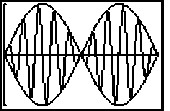Solve the problem.A product of two oscillations with different frequencies such as f(t) = sin(10t) sin(t)is important in acoustics. The result is an oscillation with "oscillating amplitude." the product f(t) of the two oscillations as a sum of two cosines and call it g(t).
the product f(t) of the two oscillations as a sum of two cosines and call it g(t). a graphing utility, graph the function g(t) on the interval 0 ? t ? 2?.
a graphing utility, graph the function g(t) on the interval 0 ? t ? 2?. the same system as your graph, graph y = sin t and y = -sin t.
the same system as your graph, graph y = sin t and y = -sin t.
src="https://sciemce.com/media/4/ppg__tttt0523191219__f1q44g4.jpg" alt="" style="vertical-align: -4.0px;" /> last two functions constitute an "envelope" for the function g(t). For certain values of t, the two cosine functions in g(t) cancel each other out and near-silence occurs; between these values, the two functions combine in varying degrees. The phenomenon is known (and heard) as "beats." For what values of t do the functions cancel each other?
What will be an ideal response?
(i) g(t) =  cos(9t) -
cos(9t) -  cos(11t)
cos(11t)
(ii), (iii)

(iv) t =  , n any integer
, n any integer
Mathematics
src="https://sciemce.com/media/4/ppg__tttt0523191219__f1q44g4.jpg" alt="" style="vertical-align: -4.0px;" /> last two functions constitute an "envelope" for the function g(t). For certain values of t, the two cosine functions in g(t) cancel each other out and near-silence occurs; between these values, the two functions combine in varying degrees. The phenomenon is known (and heard) as "beats." For what values of t do the functions cancel each other?
What will be an ideal response?
| (i) | g(t) =  cos(9t) - cos(9t) -  cos(11t) cos(11t) |

(iv) t =
 , n any integer
, n any integerYou might also like to view...
Solve the given differential equation. + 16y = sin 4x
+ 16y = sin 4x
A. y = c1 sin 4x + c2 cos 4x +  x cos 4x
x cos 4x
B. y = c1 sin 4x + c2 cos 4x -  x sin 4x -
x sin 4x -  x cos 4x
x cos 4x
C. y = c1 sin 4x + c2 cos 4x -  x sin 4x
x sin 4x
D. y = c1 sin 4x + c2 cos 4x -  x cos 4x
x cos 4x
Solve the problem.Jim has gotten scores of 93 and 85 on his first two tests. What score must he get on his third test to keep an average of 80 or greater?
A. At least 61 B. At least 62 C. At least 89 D. At least 86.0
Solve. Use ? ? 3.14. Round to the nearest tenth unless otherwise directed.The Landstar satellite orbits the Earth in a circular pattern. Assume that the radius of orbit is  If the satellite goes through one orbit around the Earth in 4 hours, what is its speed in kilometers per hour?
If the satellite goes through one orbit around the Earth in 4 hours, what is its speed in kilometers per hour?
A. 5181 km/hr B. 10,362 km/hr C. 34,194,600 km/hr D. 262.7 km/hr
Decide whether the statement is possible or impossible.tan ? = 3.1004 and cot ? = 0.32254
A. Possible B. Impossible